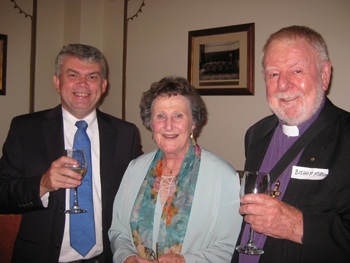ABM Archive Website
THIS WEBSITE CONTAINS ARCHIVE MATERIALS FOR HISTORICAL REFERENCE ONLY
For up-to-date information, including our latest appeals, news, and resources, please visit our current website.
Filling the Gaps for 100 years – The ABM Auxiliary – 1910
 |
| Moya Holle (centre) with the Rev John Deane (left) and Bishop Ken Mason. © Vivienne For/ABM, 2011. |
This reflection on the history of the ABM Auxiliary was written by Moya Holle, a member of the Auxiliary, on the centenary of the Auxiliary in 2010.
A centenary is a milestone, whether for an individual or a society.
When an individual reaches the “big 100” they are commonly asked for the secret of their longevity. Their answers often come down to either good genes, good nurturing or good luck and, for those with a faith in God, these things are in God’s good time.
The ABM Auxiliary definitely has good genes. The women who brought it into being, besides being leaders in both the church and society, were strong, intelligent, alert and committed. The Auxiliary was initiated in 1910 by the Governor’s wife, Lady Chelmsford. Within four months of its inception, branches were being formed around Australia. At the same time, the first Women’s Auxiliary Admission Service and a Joint Day of Missionary Intercession were held at St Andrew’s Cathedral in Sydney.
Over the past one hundred years, the Auxiliary has shown commitment, leadership and strength, both by driving projects forward and through their devotion to the Christian Mission. These women were in cities, in towns and on farms. Some were members of Auxiliary branches, others were in affiliated groups and some were members working alone.
One of the strengths of the Auxiliary is the solidarity and friendship among members all over Australia and with overseas missionaries. Since 1980, National Conferences have brought people together from all over Australia – missionaries and overseas Partners. In 2008, former President Barbara Briggs, was asked to reflect on her time on the National Council of the Auxiliary. “My first thoughts when being asked about these years were of friendships – some of these I still hold valuable after twenty years!” she wrote.
Besides the good genes, there has been good nurturing – care of the organisation itself. Much attention has been given to the structure and planning within the Auxiliary. To link up with as many Anglicans around Australia as possible, the National Council and Diocesan Committees have actively encouraged membership and participation. They would approach a (sometimes reluctant) Diocesan Bishop and request he allow an Auxiliary in the Diocese from which a representative to the National Council would be selected.
In 1913 the Auxiliary initiated the Women’s Lenten Offering which, for fifty years, raised thousands of pounds annually. In the 50s and60s, they held the National Annual Handwork Competition. From its establishment at Epping in 1929, the Auxiliary was committed to supporting the ABM Training Hostel (later College) until its closure in Stanmore in the mid 70s. This support was not simply financial – they also supported missionaries in training there.
The Auxiliary’s Special Project is an initiative that started in 1965 and has been continued every year for the past forty-five years. The first project, “Operation Deficit”, helped ABM lower its bank overdraft.
Subsequent projects have supported every area of ABM and in some instances they have seeded new projects. In 1983–84 “Operation Evangelist” saw the establishment of the Kerina Evangelists College in the Highlands of Papua New Guinea; in1986 the Auxiliary funded Cynthia Tellez, a worker for the Philippine Centre from St John’s Anglican Cathedral in Hong Kong. 24 years later, Cynthia is still working in the Philippines. In 2010, to mark the Centenary of the Auxiliary, the plan is to raise $100,000 for “Filling the Gaps”. This Special Project will provide funding for projects that might otherwise not go ahead.
Has there been good luck? Perhaps it has actually been good management. The fact that the Auxiliary has survived and been an integral part of the ABM’s support system during its trials and tribulations is testimony to that.
‹ Back


